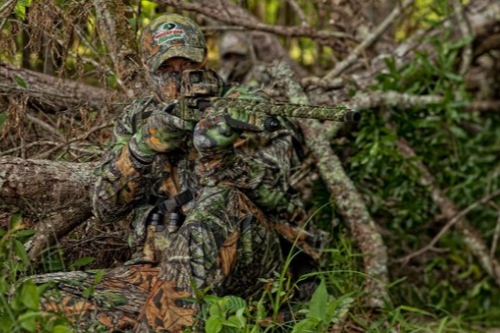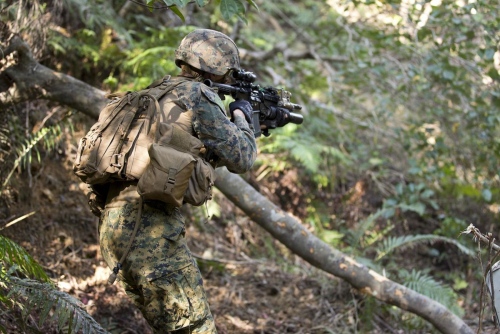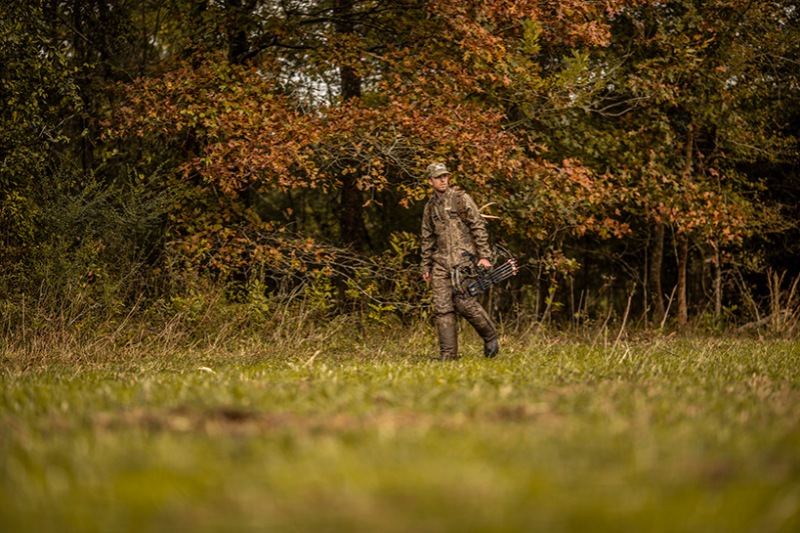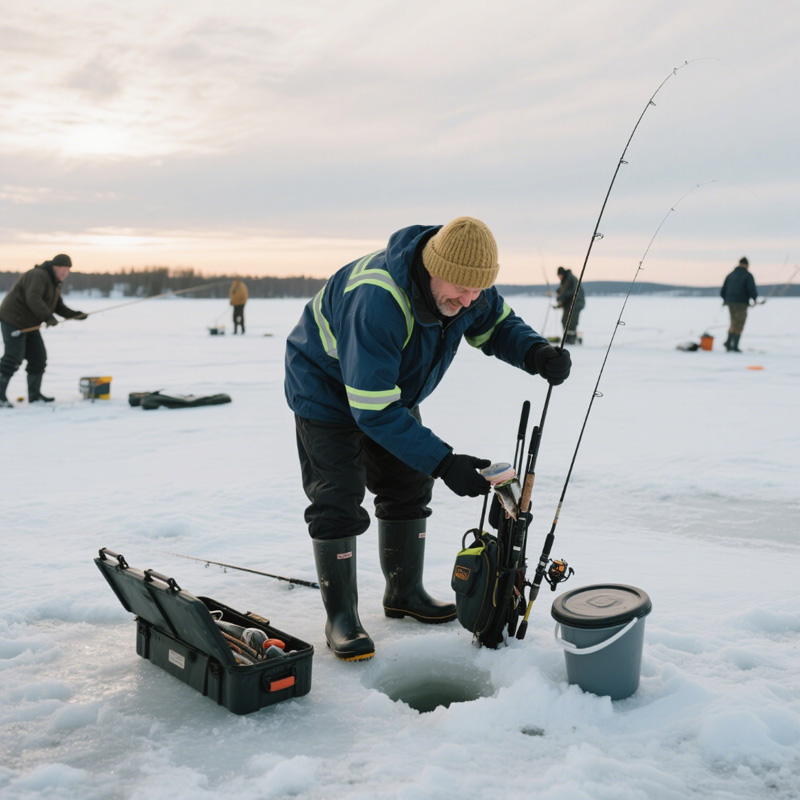Camo or camouflage is a method of concealing people, animals, or objects by making them blend into their surroundings. This technique uses colors, patterns, and materials to disrupt outlines and minimize visibility, enhancing survival and success by reducing the likelihood of being spotted.
Hunting camo and military camo are both designed to camouflage the wearer. Hunting camo is typically designed to mimic natural environments such as forests, grasslands, or marshes. It helps hunters blend in with their surroundings, making it difficult for wildlife to detect them. Military camo is designed to adapt to a variety of environments, including urban, desert, jungle, and other combat settings. This type of camouflage aids soldiers in avoiding detection by enemy forces.
As the leading OEM/ODM hunting clothing manufacturer and supplier, BOWINS Garment offers custom hunting camo jackets, vests and pants for global brands. This article tries to compare the hunting camo vs military camo or hunting camo vs army camo, highlighting their similarities, differences and considerations when choosing right camouflage in their respective environments. By examining these differences, you will gain a deeper understanding of how each type of camouflage serves its unique purpose and the considerations involved in choosing the right camouflage for specific needs.
1. What Is Hunting Camo?
Hunting camo, or hunting camouflage, is specialized attire used to conceal hunters from animals. It utilizes patterns resembling natural environments like forests, grasslands, or marshes. By mimicking these surroundings, hunters can blend in effectively and reduce the risk of being detected by wildlife. Hunting camo is designed with specific patterns that cater to different types of game and hunting seasons. The primary goal is to provide hunters with optimal concealment, enhancing their chances of a successful hunt. This specialized attire plays a crucial role in ensuring hunters remain unnoticed, allowing them to get closer to their targets without alarming them. Overall, hunting camo is an essential tool for hunters, enabling them to blend seamlessly into nature and increase their hunting efficiency.
2. What Is Military Camo?
Military camo, also referred to as military camouflage or army camo, is specifically crafted to provide concealment for military personnel against enemy forces in different combat scenarios. It incorporates patterns that can adapt to a wide range of environments, such as urban areas, deserts, jungles, and forests. The primary objective of military camo is to disrupt the visual outline of soldiers, making it challenging for adversaries to identify and target them. Advanced materials and technologies are often employed in military camo designs to enhance durability, protection, and effectiveness in diverse operational conditions. By utilizing military camo, soldiers gain an advantage by blending into their surroundings, increasing their chances of evading detection and improving overall mission success rates. This specialized camouflage plays a crucial role in safeguarding military personnel during combat operations.

Hunting Camo

Military Camo
3. What Are Similarities of Hunting Camo And Military Camo?
3.1 Purpose of Concealment
Both hunting camo and military camo are designed to conceal the wearer from their surroundings. The primary goal is to avoid detection, whether by animals in the wild or enemy forces in combat.
3.2 Use of Patterns and Colors
Both types of camouflage utilize specific patterns and colors to blend into the environment. These patterns often mimic natural elements like foliage, terrain, and other surroundings to disrupt outlines and minimize visibility.
3.3 Material Technology
Both hunting and military camo often employ advanced materials that offer durability and comfort. These materials are chosen for their ability to withstand harsh conditions and provide some level of protection.
3.4 Seasonal and Environmental Adaptation
Both types of camo are designed to be effective in various environments and conditions. Hunting camo adapts to different seasons and types of game, while military camo adapts to diverse combat environments such as deserts, forests, and urban areas.
3.5 Strategic Importance
Effective camouflage is crucial for the success of both hunters and military personnel. In hunting, camo increases the chances of a successful hunt by reducing the likelihood of being detected by animals. In military operations, camo enhances survival and mission success by reducing the risk of being spotted by the enemy.
3.6 Evolution and Innovation
Both hunting and military camo have evolved over time with advancements in technology and design. Continuous innovation aims to improve the effectiveness of camouflage patterns and materials to better serve the specific needs of hunters and military personnel.
4. What Is Difference Of Hunting Camo vs Military Camo?
The distinction between Hunting Camo Vs Military Camo lies primarily in their intended use and design considerations, though there may be some overlap. Here are the key differences:
4.1 Different Application
Hunting Camo: As the name suggests, hunting camouflage is specifically designed for hunting activities. It aims to provide hunters with optimal concealment in various natural environments such as forests, grasslands, and wetlands.
Military Camo: Military camouflage, on the other hand, is developed for military operations. It serves to protect soldiers from being detected by enemy forces in a wide range of terrain and lighting conditions.
4.2 Different Design Considerations
Both Hunting Camo and Military Camo utilize patterns and colors to break up the human form and blend into the surroundings. However, their specific design elements may differ based on the intended environment and operational needs.
Hunting Camo tends to focus more on natural colors and patterns that mimic the specific hunting terrain. For example, a hunting camo for a forest environment might feature earthy tones and leafy patterns.
Military Camo, on the other hand, often incorporates more complex patterns and colors that are effective in a wider range of settings. It may also include features such as infraredreducing materials to reduce visibility on nightvision devices.
4.3 Different Functionality and Durability
Both types of camo are typically made with durable materials that can withstand the rigors of outdoor use. However, Military Camo may place a higher emphasis on durability and functionality, as soldiers need to rely on their gear in extreme conditions.
Military camo often includes additional features such as reinforced seams, waterproofing, and breathability to ensure soldiers remain comfortable and protected in all environments.
4.4 Different Customization and Availability
Hunting Camo is widely available from various manufacturers and often comes in a range of styles and sizes to suit individual hunters’ preferences and needs.
Military Camo, while also available to civilians through certain channels, is typically more regulated and may be subject to stricter guidelines regarding its use and distribution.
It’s worth noting that these distinctions are general in nature, and there may be instances where hunting camo and military camo overlap in terms of design and functionality. Ultimately, the choice between the two will depend on the specific needs and preferences of the individual user.
It’s important to acknowledge that camouflage technology is constantly evolving, and new designs and materials are being developed to meet the changing demands of hunters and military personnel.

5. What Are Considerations When Choosing Between Hunting Camo vs Military Camo?
When it comes to choosing between hunting camouflage (camo) and military camo, there are several considerations to keep in mind. Here are some of the key factors to consider:
5.1 Purpose
The primary factor to consider is the purpose for which you need the camo. If you are going hunting, then hunting camo would be more suitable as it is designed to blend in with natural surroundings like trees, grass, and bushes. On the other hand, if you are looking for something that provides better concealment in a tactical or combat situation, then military camo would be more appropriate.
5.2 Environment
Another important consideration is the environment in which you will be using the camo. Hunting camo is typically designed to work well in wooded areas and other natural environments where game animals are found. Military camo, on the other hand, is often designed to work well in a variety of environments, including urban settings and desert terrain.
5.3 Color Scheme
The color scheme of the camo is also an important consideration. Hunting camo typically uses earth tones like brown, green, and gray to help blend in with natural surroundings. Military camo, on the other hand, may use a wider range of colors depending on the specific design and intended use.
5.4 Durability
durability is another important factor to consider. Hunting camo is generally designed to be lightweight and comfortable for extended periods of sitting or standing still, while military camo is often designed to be more durable and resistant to wear and tear in extreme conditions.
6. Conclusion
Hunting camo and military camo are both designed to camouflage the wearer. Hunting camo is widely available in various styles and sizes to suit individual preferences. Military camo, while accessible to civilians through specific channels, is typically more regulated with stricter guidelines for use and distribution.
These distinctions are general, and there can be instances of overlap between hunting and military camo in design and functionality. The choice between the two depends on individual needs and preferences.
The choice between hunting camo and military camo depends on your specific needs and preferences. Consider the purpose, environment, color scheme, and durability when making your decision.
Any questions, please let us known.




